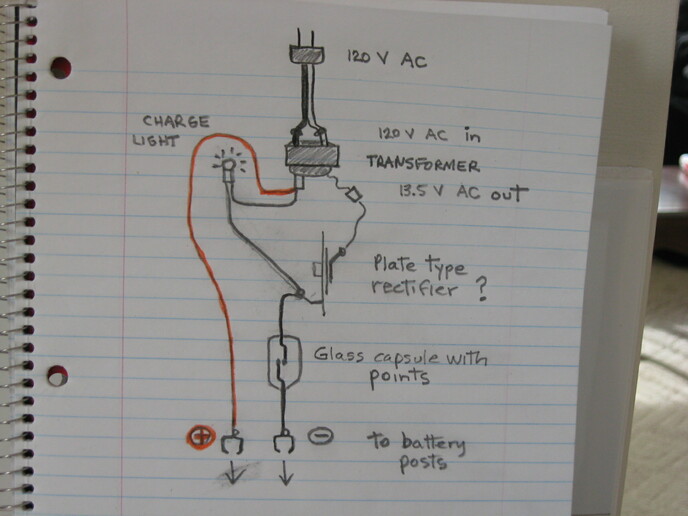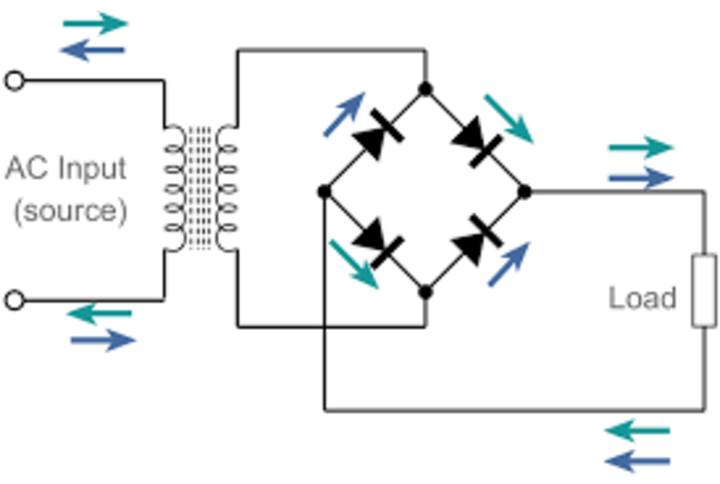Crazy Horse
Well-known Member
Well, I need help, hopefully those in the know can help me. I have an older 12 Volt 2 amp charger that only kicks out about 0.5 volts DC when measured at the output clips.. There is no charging rate meter gauge on this charger but there is a little light (which I call a charging light but maybe it's a polarity check light, not sure). See the diagram below and my description of what's there follows.
From top to bottom in my diagram ..... I have a 120 Volt AC input (household) which hooks up to a step-down transformer. I think that's the correct term. When plugged into house current by itself (not tied into the charger wiring), the transformer shows 13.6 Volts AC coming out of it so it appears to be working. I think the rest of the diagram is self explanatory.
Some other things ........ I believe it is a 'plate-type rectifier' I labelled that is supposed to covert the 13.6 V AC current to DC current right? Then there is that little glass capsule with a set of points inside (currently closed), maybe some kind of a charge limit control or something like that? Or safety shut off? I have current continuity through the rectifier. Once this is all hooked up and plugged in, I have only checked the DC volt output at the clips that hook up to the battery (and got that tiny reading).
So a simple question and maybe a simple answer. Any ideas as to what is wrong here or not working? Or what I need to test further or do to put this charger to use?
PS: I did a little test thinking that maybe the battery charger only kicks out full charge when hooking up to a 12V battery. I tested a battery by itself and it read 12.4 volts. I then hooked up the charger to the battery and plugged it in. The DC reading at the battery posts remained unchanged at 12.4 volts so the charger appears not to be having any effect when hooked up. I guess my volt meter is just reading the existing battery voltage when I do that.

From top to bottom in my diagram ..... I have a 120 Volt AC input (household) which hooks up to a step-down transformer. I think that's the correct term. When plugged into house current by itself (not tied into the charger wiring), the transformer shows 13.6 Volts AC coming out of it so it appears to be working. I think the rest of the diagram is self explanatory.
Some other things ........ I believe it is a 'plate-type rectifier' I labelled that is supposed to covert the 13.6 V AC current to DC current right? Then there is that little glass capsule with a set of points inside (currently closed), maybe some kind of a charge limit control or something like that? Or safety shut off? I have current continuity through the rectifier. Once this is all hooked up and plugged in, I have only checked the DC volt output at the clips that hook up to the battery (and got that tiny reading).
So a simple question and maybe a simple answer. Any ideas as to what is wrong here or not working? Or what I need to test further or do to put this charger to use?
PS: I did a little test thinking that maybe the battery charger only kicks out full charge when hooking up to a 12V battery. I tested a battery by itself and it read 12.4 volts. I then hooked up the charger to the battery and plugged it in. The DC reading at the battery posts remained unchanged at 12.4 volts so the charger appears not to be having any effect when hooked up. I guess my volt meter is just reading the existing battery voltage when I do that.





